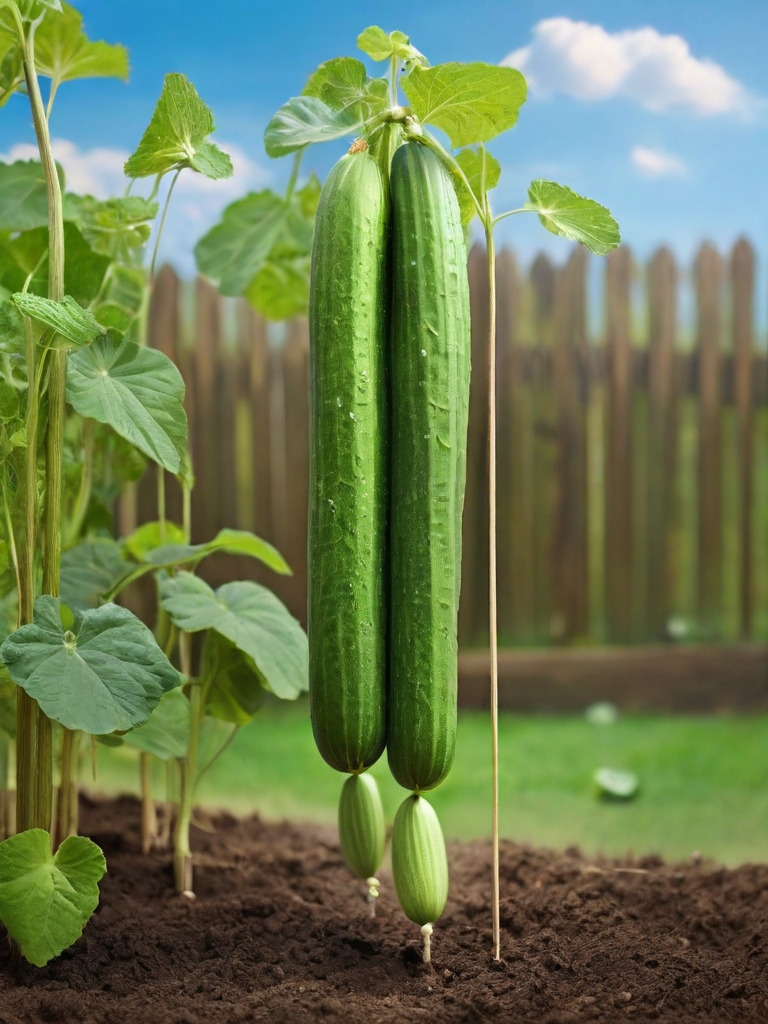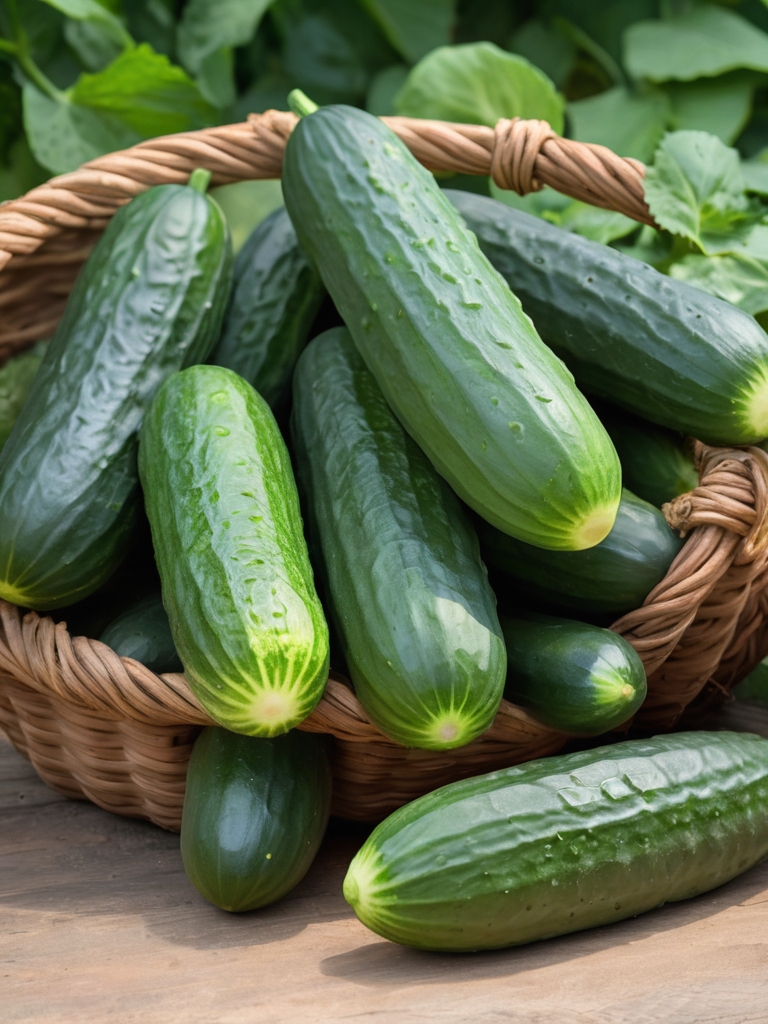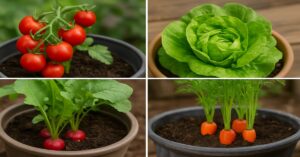Cucumbers are a garden favorite, but growing them in limited space can be problematic. That’s where vertical gardening comes in! Growing cucumbers vertically saves space, improves plant health, makes harvesting easier, and expands yield. This method enables better air circulation, reduces pests, and ensures a cleaner garden.
Whether you’re a beginner or a pro, this guide will show you how to grow cucumbers the right vertical way—from selecting the best varieties to building a strong trellis and managing common issues. Let’s get started on your journey to a bountiful cucumber harvest!
Why Grow Cucumbers Vertically?
Cucumbers, like other vining plants, naturally spread out on the ground. However, when you grow cucumbers vertically, you can make better use of your garden space while providing the plants with more exposure to sunlight, improving airflow, and lowering the risk of diseases.
Key Benefits of Vertical Cucumber Gardening:
- Space Efficiency: Vertical gardening makes the most of the available space if you’re limited to small garden beds or growing on a balcony.
- Improved Air Circulation: Elevating the plants helps reduce humidity around them, making them less favourable for diseases like mildew.
- Cleaner Fruits: WCucumbers grown off the ground have less potential to rot or be infested with pests.
- Easier Harvesting: No more bending over or crawling on the ground. Picking cucumbers becomes a much easier task when they’re elevated.
- Healthier Plants: Vertical gardens provide a better framework for the cucumbers to grow strong and beneficial.
With these advantages in mind, let’s dive into the step-by-step process of growing cucumbers the right vertical way.
Choosing the Best Cucumber Varieties for Vertical Gardening
Not all cucumbers are suitable for growing up. To get good results, pick the correct type of plant that grows long vines, climbs easily, and makes a lot of fruit.
Vining cucumber types are great for this method because they grow upward with the proper support, saving space and increasing your harvest. Picking the right cucumber helps your vertical garden grow well and gives you a good harvest.
Recommended Varieties for Vertical Growth:
- Marketmore 76: This disease-resistant cucumber variety is perfect for vertical gardening. It produces long, dark green cucumbers that are perfect for slicing. These cucumbers tend to be straight, reducing the risk of deformation when grown vertically.
- Lemon Cucumber: This plant has small, round, yellow fruits and is excellent for vertical gardens. Lemon cucumbers are tasty, and their small size is perfect for tiny areas.
- Suyo Long: This heirloom cucumber variety produces elongated, curved fruits with a mild, sweet flavour. Suyo Long cucumbers are great for salads and make a stunning addition to any vertical garden.
- Armenian Cucumber: Often considered more of a melon than a cucumber, Armenian cucumbers have long, slender fruits with a crisp texture. They thrive in warm conditions and grow well on a trellis.
- Bush Cucumbers: While bush cucumbers aren’t as common for vertical gardening, some varieties can be trained to climb. These plants are more compact and easier to manage in smaller spaces.
Choosing the Right Cucumber for Your Space:
- For Small Spaces: Opt for compact varieties like Lemon or Bush Cucumbers. These will climb but require less room to spread.
- For Larger Gardens: Go for vining types such as Marketmore 76 or Suyo Long, which will take full advantage of a larger trellis system.
Building a Trellis for Vertical Cucumber Gardening
To grow cucumbers vertically, you need a solid, reliable trellis to support the vines and fruits as they grow. The trellis is a key component in vertical gardening because it helps guide the vines and ensures that cucumbers remain elevated off the ground.
Best Trellis Designs for Cucumbers:
- A-Frame Trellis: This is one of the most popular trellis designs for cucumbers. The A-frame trellis connects two panels at the top to form an “A” shape. This design supports cucumber vines and allows them to spread evenly on both sides, maximizing the growing space.
- Vertical Panel Trellis: A simple, upright frame made from wood, metal, or mesh is excellent for smaller gardens or patios. Vertical trellis panels allow cucumbers to climb naturally while being fully supported as the plants mature.
- Arch Trellis: An arch trellis forms a tunnel through which cucumbers can climb. This trellis works well in garden paths or entrances, and as the cucumbers grow, they hang down for easy harvesting.
- String or Net Trellis: This option uses ropes or netting attached to a frame to create an easy and effective way to garden vertically. It’s perfect for small and light types of cucumbers. Ensure the net is strong enough to support the vines and fruits as they grow.
Building a Sturdy Trellis:
To build your trellis, pick strong and bendable materials. Materials like wood, metal, or plastic pipes are good choices. To make it even stronger, use galvanized wire or twine to support the cucumber plants as they grow.
DIY Trellis Materials:
- Wooden slats or bamboo poles for a sturdy frame
- Heavy-duty netting or chicken wire for climbing support
- Twine or rope to guide the cucumber vines
- Metal stakes or rebar for added stability
Planting Cucumbers Vertically

Step-by-Step Planting Guide:
Preparing the Soil: Cucumbers need well-drained, nutrient-rich soil with a slightly acidic pH (6.0-7.0). Mix in compost or well-rotted manure to enhance drainage and fertility if your soil is rich.
Sunlight and Space: Choose a spot with 6-8 hours of sunlight daily. Space plants are 12-18 inches apart to permit proper air circulation and healthy growth.
Planting Seeds or Seedlings:
- Direct sowing: Plant seeds 1 inch deep near the trellis.
- Starting indoors: Start seedlings 3-4 weeks before the last frost and harden them off before transplanting.
Training the Vines: Gently guide growing vines onto the trellis using soft ties or twine, ensuring they stay supported and grow upwards.
Watering and Fertilizing Cucumbers Vertically
Cucumbers need steady moisture to grow well, especially when blooming and producing fruit. Growing cucumbers vertically needs careful watering and feeding to keep your plants healthy and give you a good harvest.
Watering Tips:
- Water the bottom of the plant well, but don’t get the leaves wet. Wet leaves can cause fungus to grow.
- Cucumbers require 1 to 2 inches of water each week, depending on where you live. Make sure to change your plans according to the rain and the weather.
- Spread mulch around the bottom of the plants to keep the soil moist, stop weeds from growing, and control the soil temperature.
Fertilizing Cucumbers:
- Before planting: Add organic compost to your soil to provide a steady supply of nutrients.
- During growth: Apply a balanced fertilizer (preferably organic) every 2-3 weeks to encourage strong vine growth and fruit production. You can also use compost tea or a fish emulsion fertilizer.
Pest and Disease Management
Growing cucumbers vertically can help reduce the risk of pests and diseases, but you’ll still need to monitor potential issues.
Common Pests:
- Cucumber Beetles: These pests can hurt your plants by eating their leaves and spreading sickness. Use natural bug sprays like neem oil to manage them.
- Aphids: These small insects suck the sap from your cucumber plants, weakening them—control aphids by introducing ladybugs or using insecticidal soap.
- Spider Mites: Spider mites live well in dry places and can harm cucumber leaves. If you see tiny webs or leaves that look different in color, use insecticidal soap or neem oil to treat them.
Diseases: This fungus grows well in wet places. Make sure there’s enough air around the plants, and water them at the bottom to prevent mildew from growing. If you see mould, remove the affected leaves and use a natural fungus killer.
Pruning and Maintaining Vertical Cucumbers
Pruning is key to keeping your cucumber plants healthy and helping them produce more fruit. Regular upkeep makes sure your vines don’t get overcrowded or tangled.
Start by removing side shoots that aren’t adding to the main vine’s growth. This helps the plant focus energy where it’s needed most. If you see any yellowing or diseased leaves, remove them to improve airflow and prevent the disease from spreading.
Once the vines reach the top of your trellis, pinch back the growing tips. This encourages the plant to grow sideways and produce even more cucumbers.
Supporting the Growth of Cucumbers
Trellis Maintenance and Adjustments:
As your cucumber vines grow, they might need extra help to stay on track. The cucumbers’ weight and the vines’ natural sprawling tendency can cause them to sag or need reinforcement. Here’s how to keep everything secure:
Reinforce the Trellis: Make sure your trellis is strong enough to hold the weight of the growing cucumbers. Add extra support posts or crossbars to keep the structure stable and prevent it from leaning or falling over if needed.
Guide the Vines: As your cucumbers grow, gently guide the vines upward on the trellis to keep them from falling or spreading out on the ground. Use soft twine or fabric ties to secure them, but avoid tying them too tightly to prevent damage to the stems.
Pruning for Better Airflow: Along with regular pruning, sometimes excessive vines that aren’t helping the main stem are trimmed. This directs the plant’s energy toward producing cucumbers and enhances airflow, which is essential for disease prevention and better fruit production. Regular pruning keeps your cucumbers healthy and productive.
Maximizing Cucumber Yield
A vertical garden has many benefits for growing cucumber plants better. Using the correct methods, you can get more cucumbers and have plenty to eat all season.
Techniques for Boosting Yield:
- Provide Support for Cucumbers: As cucumbers grow, the significance of the fruit can cause the vines to droop. To prevent this, add slings or small fabric pouches to support larger fruits. Place the cucumber in the sling and tie it to the trellis to prevent it from prematurely breaking off the vine.
- Ensure Proper Pollination: Cucumbers are typically pollinated by bees and other pollinators. Plant flowers nearby to attract beneficial insects and ensure your plants produce a bountiful crop. You can also hand-pollinate flowers by gently brushing the male flowers against the female flowers to spread the pollen.
- Avoid Overcrowding: While vertical gardening allows you to grow multiple cucumber plants, it’s essential to ensure that each plant has enough room to breathe. Too much overcrowding can lead to poor air circulation and hinder fruit production. Make sure you space the plants correctly and trim them back when necessary.
- Optimal Fertilization: Regular fertilization throughout the growing season is essential for maintaining a healthy cucumber plant. Cucumbers are heavy feeders; providing them with the vital nutrients at the right time can significantly boost their yield. Use a balanced, water-soluble fertilizer rich in nitrogen, phosphorus, and potassium.
Harvesting Cucumbers the Right Way

It’s important to know when and how to pick cucumbers as much as it is to grow them. To enjoy fresh, crunchy cucumbers, pick them at the right time. Cucumbers can taste bitter and become less crunchy when they get too ripe.
When to Harvest Cucumbers:
- Pick them young: Cucumbers are best harvested when they’re still young and tender. For slicing cucumbers, wait until they’re about 6-8 inches long for the finest flavour and texture.
- Check color: Look for cucumbers that are fully colored and firm to the touch. Depending on the variety, they could be green, yellow, or even white when they’re ripe. For pickling cucumbers, pick them when they’re smaller, typically around 4-6 inches long.
- Avoid overgrowth: If cucumbers are left on the vine too long, they’ll start to yellow, soften, and taste bitter. Be sure to harvest them promptly so the plant can continue producing fresh, tasty cucumbers.
- Use sharp tools: When picking the cucumbers, use scissors or clippers to cut them off the plant. Don’t pull or twist them, as it can hurt the plant.
How to Harvest:
- Gently grasp the cucumber near the stem and cut it off with sharp garden shears, leaving some stems behind to avoid damaging the vine.
- If you are harvesting for pickling, select still small and firm cucumbers, ensuring the best texture for preserving.
- Pick larger slicing cucumbers when fully grown but still tender to maintain the ideal flavour.
Creative Ways to Use Your Cucumbers
Now that you’ve grown and harvested your cucumbers, it’s time to get creative with using them in your meals. Cucumbers are versatile, refreshing, and perfect for many different dishes.
Cucumber Salad: One of the easiest and most refreshing ways to enjoy cucumbers is in a salad. Slice the cucumbers and toss them with fresh herbs, olive oil, vinegar, and a pinch of salt. It’s a light, crisp side dish perfect for any meal.
Pickled Cucumbers: If you’ve got a big harvest, pickling cucumbers is an excellent way to preserve them. You can make classic dill pickles or try sweet ones—both are simple and delicious.
Cucumber Water: Infuse your water with cucumber slices for a naturally refreshing drink. Add a rare sprig of mint and a squeeze of lemon for a burst of extra flavour that’s perfect for hot days.
Cucumber Smoothies: Cucumbers make a great addition to smoothies, adding a mild, crisp flavor without overpowering the drink. Combine cucumbers with fruits like pineapple or berries and a splash of lemon juice for a refreshing treat.
Cucumber Sandwiches: Create a classic sandwich using soft bread, cream cheese, and thinly sliced cucumbers. This is a perfect snack for a light afternoon meal or a tea party.
Common Problems in Vertical Cucumber Gardening and How to Solve Them
While vertical cucumber gardening is generally more efficient and healthier for the plants, it can also present challenges. Here’s how to deal with common issues that may arise.
Problem: Poor Fruit Production
If your cucumber vines are growing but not producing much fruit, several factors could be causing this, such as poor pollination, improper watering, or nutrient imbalances.
Solution:
- Improve Pollination: If pollinators like bees aren’t around, hand-pollinate your cucumber flowers to ensure both male and female ones get pollen.
- Proper Care: Make sure your cucumbers are getting enough water and nutrients. Water deeply at the base and use balanced fertilizer to encourage fruit production.
- Temperature Regulation: Cucumbers love warm temperatures. It can affect fruit production if it’s too cold or too hot. Consider using row covers to create the proper growing environment.
Problem: Yellowing Leaves
Yellowing leaves could signal issues like nutrient deficiencies, overwatering, or disease.
Solution:
- Check Soil Drainage: Poor soil drainage can lead to root rot, severely affecting your cucumber plants. Ensure your soil allows for good water flow. If it’s dense or heavy, improve its structure by adding organic matter like compost to help drainage.
- Fertilize Properly: Cucumbers are nutrient-hungry plants, especially when it comes to nitrogen for healthy leaf growth. Use a balanced fertilizer to ensure your cucumbers get the right nutrients they need for optimal growth and strength.
- Remove Infected Leaves: If you notice yellow or damaged leaves, trim them away to help prevent the spread of disease. This keeps the plant focused on healthy growth and fruit production.
Problem: Pests and Insects
Cucumbers can attract pests like cucumber beetles, aphids, and spider mites.
Solution:
- Organic Pest Control: Use organic treatments like neem oil, diatomaceous earth, or insecticidal soap to treat pest problems. You can also introduce beneficial insects like ladybugs to help control aphid populations naturally.
Final Thoughts on Growing Cucumbers Vertically
Growing cucumbers vertically is a fun, space-saving, and incredibly rewarding way to garden. Following the steps in this guide will increase your harvest and allow you to enjoy fresh, crisp cucumbers throughout the season.
The key to success with vertical cucumber gardening is simple: provide strong support, care for your plants regularly, and address issues as soon as they arise. Choose the right cucumber varieties, build a solid trellis, and keep your plants healthy, and you’ll be set for a season full of bountiful, homegrown cucumbers.
Happy gardening, and may your vertical cucumber garden thrive!




